Recent Articles
Popular Makes
Body Types
2024 Subaru Solterra vs. 2024 Volkswagen ID.4
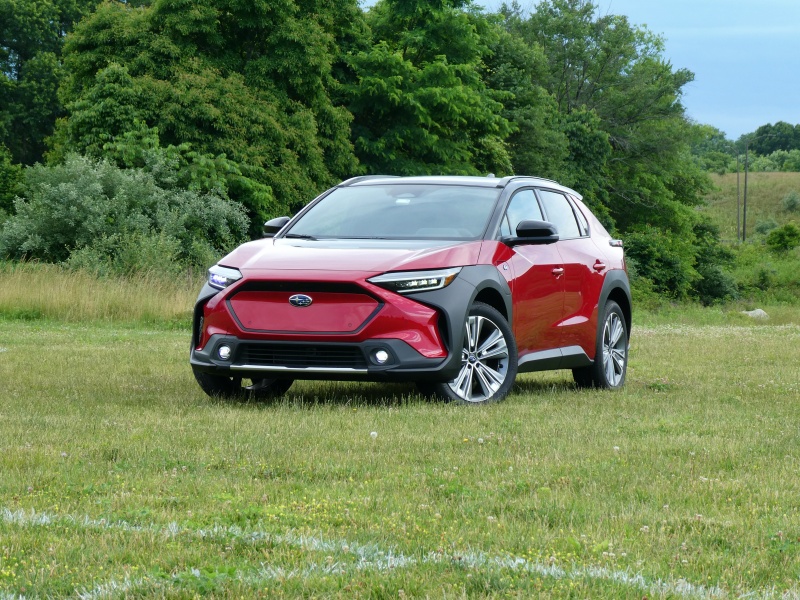
2024 Subaru Solterra ・ Photo by Brady Holt
If you’re interested in an electric vehicle, you have more choices than ever. And while ultra-slick luxury models get a lot of attention, you can also go electric in a sensible, affordable compact crossover – like the 2024 Subaru Solterra and 2024 Volkswagen ID.4.
The ID.4 and Solterra are comfortable and functional, come well equipped at sticker prices in the $40,000s, and often qualify for ultra-cheap lease deals and other discounts. But which one is best? We just tested both crossover EVs for a week to compare them in each of eight categories, then name an overall winner. Keep reading to find out which one we chose and which sounds like the better electric SUV for you.
Pricing and Features
The 2024 Volkswagen ID.4 starts at $39,735 versus $44,995 for the cheapest 2024 Subaru Solterra. That gives the VW a compelling advantage if you’re looking for the cheapest way to get behind the wheel of an electric crossover. Plus, most ID.4 buyers will qualify for a $7,500 tax credit – available for U.S.-built EVs whose battery materials come mainly from the U.S. and its trade partners. So you can mentally subtract $7,500 from the ID.4’s sticker price before you even start haggling. The Solterra, built at a Toyota factory in Japan, only has that discount for leases.
Subaru has one notable justification for its higher price. All-wheel drive is standard on every Solterra (like on most Subarus), while the cheapest AWD ID.4 is the $48,755 Pro model. Still, factoring in the tax credit and the Pro trim level’s extra standard features, the ID.4 is still the value leader unless your Subaru dealer cuts you an enormous discount. You’ll also find that these can be respectable bargains even compared with gas SUVs when you factor in incentives and their generous standard equipment.
Winner: Volkswagen ID.4

2024 Volkswagen ID.4 ・ Photo by Brady Holt
Range and Charging
The Solterra travels an EPA-estimated 222 miles on a charge at an energy equivalent of 102 miles per gallon (or 227 miles at 104 MPGe on the slightly lighter base model). That’s excellent efficiency and more than enough range for most folks’ everyday use. And a 240-volt car charger, like you could install in your garage, can refill a fully depleted battery in 11 hours. When you venture farther from home, a DC fast charger can bring the 2024 Solterra from 10 percent to 80 percent capacity in just 35 minutes – a big improvement over last year’s model.
Still, the ID.4 goes farther. While the base models manage just 206 miles per charge (at 107 MPGe), an optional upgraded “Pro” battery back pushes the rear-wheel-drive ID.4 to an excellent 291 miles (at 113 MPGe). AWD ID.4s split the range difference with an EPA-estimated 263 MPGe, and they match the Solterra’s efficiency and charging speed.
We drove 255 miles in our RWD ID.4 Pro S and recharged with an estimated 55 miles and 17 percent of remaining charge, which beats the EPA’s estimate. We were similarly on track to hit 270 miles with an AWD model we tested last year. The Solterra, by contrast, made it 174 miles with an estimated 59 miles or 29 percent remaining – barely edging out a much lower EPA estimate. Subaru throws in 10 days of free rentals of gas-powered Subarus for longer trips, but the VW wins this category.
Winner: Volkswagen ID.4
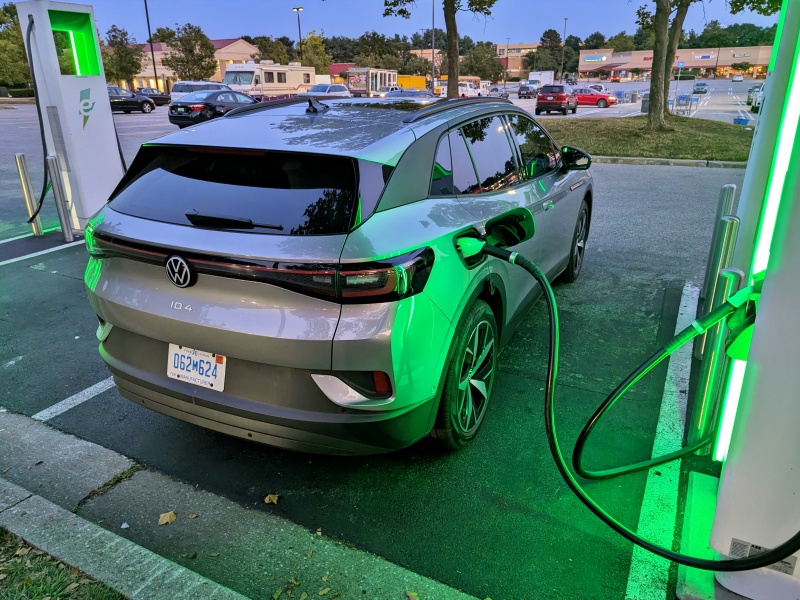
2024 Volkswagen ID.4 ・ Photo by Brady Holt
Exterior Design
Neither the Solterra nor the ID.4 looks quite like a conventional crossover. Both are lower and sleeker than the typical tall boxes – not surprising, since improved aerodynamics means a longer range. Still, you won’t confuse these EVs with each other.
The ID.4 is a sleek pod, gently rounded and without nods to SUV-like rugged, outdoorsy performance. That’s the hallmark of the Subaru brand, however, and you’ll see that in the Solterra’s gray plastic fenders and angular face. (The Solterra also looks nearly identical to its platform-mate, the Toyota bZ4X.) We’ll let you make this judgment call between the Subaru and Volkswagen design philosophies.
Winner: Tie
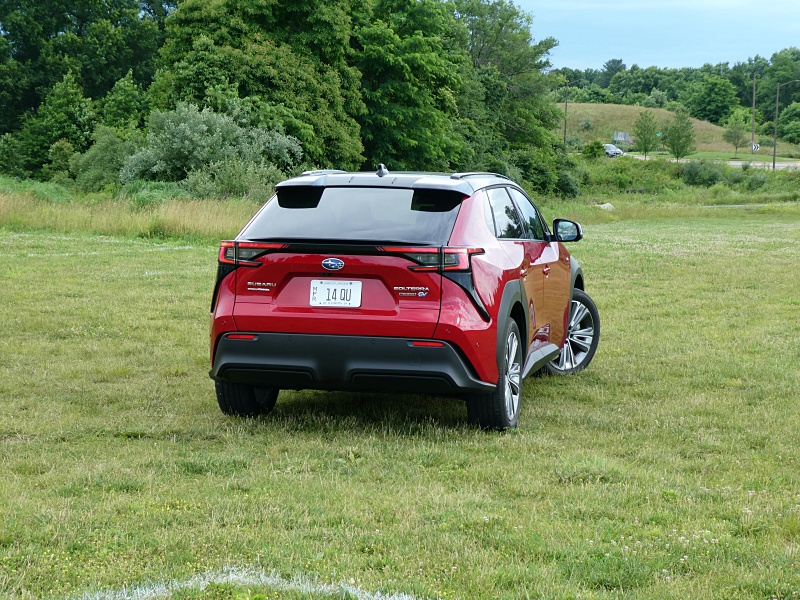
2024 Subaru Solterra ・ Photo by Brady Holt
Interior Design
Inside, the ID.4 and Solterra are generally well-finished for affordable crossovers, and both have big touchscreens on their dashboards. And both have hard-to-forgive ergonomic shortcomings.
The Solterra comes standard with a modest 8-inch screen, but most of the lineup has a 12.3-inch unit. However, the Solterra’s Toyota system leaves lots of empty white space and makes you constantly switch views to see different information. Below the screen, most climate controls are on a flat touch-sensitive surface that forces you to take your eyes off the road. We prefer the ID.4’s infotainment system to the Solterra’s, especially after all but the base model got an improved interface this year. But the ID.4 complements the 12.9-inch screen with other controls that are even harder to use. Touch-sensitive steering wheel controls activate when you brush your hand over them, but often don’t when you actually try to use them. Climate temperature and audio volume are tiny “sliders.” The driver can’t even put down the rear windows without tapping at a touch-sensitive button (repeatedly, in our experience). That's because VW provides only two window switches, which must serve double duty for both the front and rear windows.
We’ll award this category to the marginally less frustrating Solterra, but either car is a few upgrades away from an easy victory.
Winner: Subaru Solterra
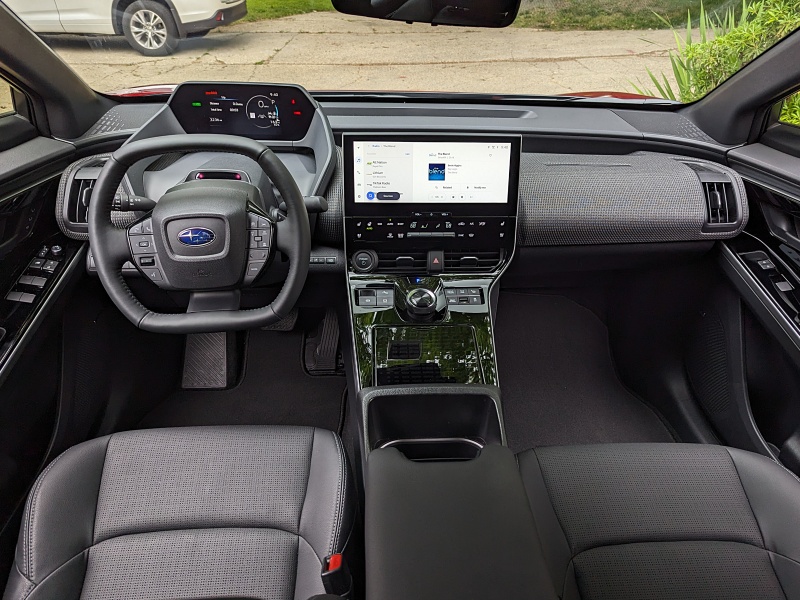
2024 Subaru Solterra ・ Photo by Brady Holt
Passenger and Cargo Accommodations
Both the Solterra and ID.4 are comfortable, spacious rides for up to five passengers and some cargo. They have well-shaped, comfortable front seats and plenty of rear legroom, though the Solterra’s backseat is a bit low to the floor.
We’ll give the ID.4 the nod for its greater cargo capacity. Although the Solterra is 4 inches longer than the ID.4, the Subaru’s tapering roofline cuts into storage space versus the more upright VW. In total, you get 23.8 cubic feet behind the Solterra’s backseat and 63.5 cubic feet with the rear seat folded. The ID.4 manages 30.3 cubic feet behind the rear seat and 64.2 cubic feet behind the front seats. Also, while the ID.4 can tow up to 2,700 pounds, the Solterra isn’t rated to handle any trailer.
Winner: Volkswagen ID.4

2024 Volkswagen ID.4 ・ Photo by Brady Holt
Acceleration
EVs are known for their swift, near-silent acceleration, and these two crossovers deliver. They’re faster and much more hushed than gas-powered compact SUVs like a Subaru Forester or Volkswagen Tiguan. Still, especially after a fresh upgrade for 2024, the ID.4 is the clear winner for speed.
The Solterra makes 215 horsepower and 249 lb-ft of torque. That’s much better than a Forester, especially since the electric Solterra avoids the rasp of a basic four-cylinder gas engine. But it can’t keep up with the new ID.4. The Volkswagen’s base model is on par with the Subaru with 201 hp and 229 lb-ft of torque, but the larger battery pack also brings more power: 282 hp and 402 lb-ft of torque. That moves from adequate performance to sports-car-level speed. Upgrading the VW to AWD bumps you to 330 hp. We even found the ID.4 easier to drive gently as well as to drive fast; the Solterra’s throttle felt touchier in low-speed conditions.
Winner: Volkswagen ID.4
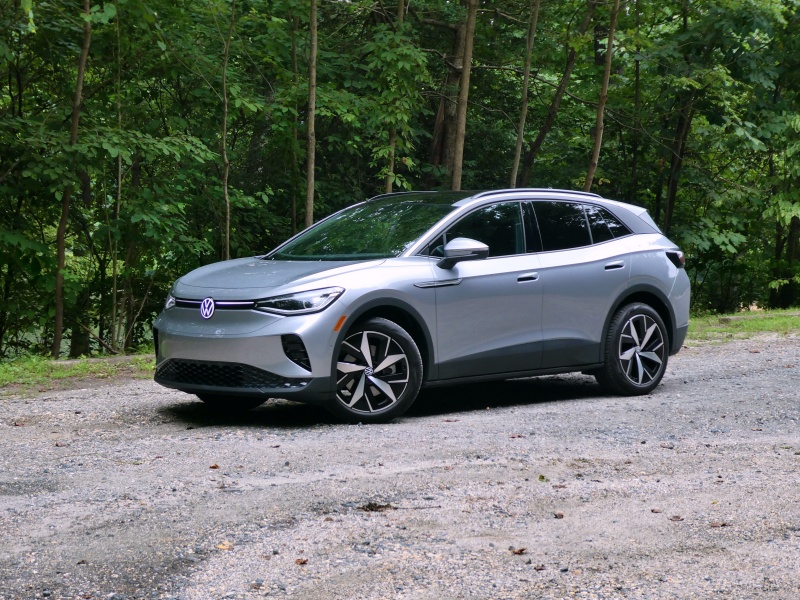
2024 Volkswagen ID.4 ・ Photo by Brady Holt
Ride and Handling
Aside from the Volkswagen’s greater speed, the ID.4 and Solterra are fairly similar to drive. They’re comfortable, quiet, and more agile than most small SUVs. Credit their lower roofs and their heavy batteries under the floor, both of which lower their centers of gravity. The ID.4 is tuned with a firmer suspension for slightly zippier performance, while the Solterra is slightly calmer over bumps. But the difference isn’t night and day.
We will give the Solterra the edge for its extra all-weather capability. In addition to standard AWD, it includes Subaru staples like X-Mode settings for snow/dirt or deep snow/mud; hill-descent control; and a higher ground clearance: 8.3 inches on all models (versus 6.8 inches for AWD ID.4 versions and just 6.0 inches for rear-drive VWs). If you’re not interested in this extra capability and prefer sportier handling over a smoother ride, you’d prefer driving the ID.4. But our winner is the Subaru.
Winner: Subaru Solterra
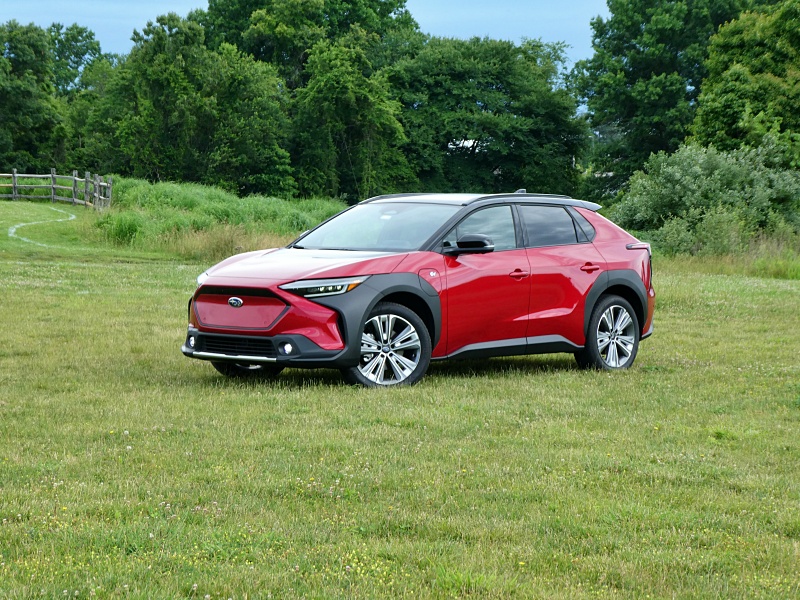
2024 Subaru Solterra ・ Photo by Brady Holt
Safety
The Solterra and ID.4 are two safe SUVs. Both earn five out of five stars from the National Highway Traffic Safety Administration. Both earned Top Safety Pick status from the Insurance Institute for Highway Safety. And both come packed with standard safety gear: forward automatic emergency braking, blind-spot monitoring, and lane-departure warnings with automatic steering assistance.
We’ll give the Solterra a slight edge for a couple reasons. Its automatic emergency braking system proved slightly more effective than the VW’s in IIHS testing, and its base-model headlights outshone the ID.4’s. Plus, only the Solterra includes rear automatic braking for while you’re backing up.
Winner: Subaru Solterra
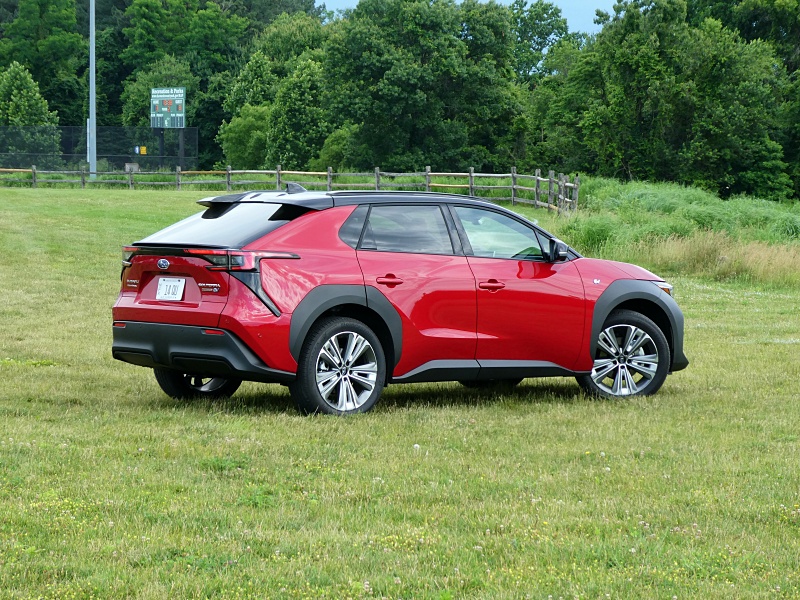
2024 Subaru Solterra ・ Photo by Brady Holt
Final Thoughts
The 2024 Subaru Solterra is an agreeable EV. It’s comfortable, functional, safe, easy to drive, and incredibly economical. But our winner is the 2024 Volkswagen ID.4.
The ID.4 is not the perfect crossover. It's less adept in mud and snow than the Solterra, and we consider its control layout even worse than the already-flawed Subaru’s. But in each of the most significant differences between the two crossovers, the ID.4 comes out on top. It costs much less if you qualify for the EV tax credit. It goes much farther on a charge if you skip the base model. And it’s much quicker. Not everyone will need these advantages, and some might find a bigger discount on a Solterra, value its extra off-road capability, or prefer its cushier ride. But the ID.4 is the better electric crossover for more people.
Winner: Volkswagen ID.4
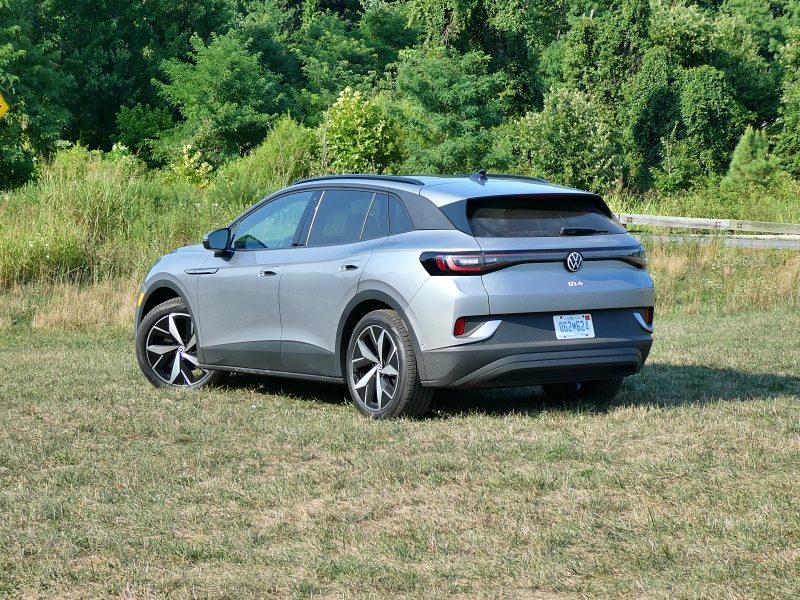
2024 Volkswagen ID.4 ・ Photo by Brady Holt